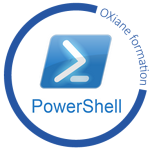Prochaines sessions
Programme
Module 1: Creating advanced functions
- Description
- This module explains how to parameterize a command into an advanced function
- Lessons
- Converting a command into an advanced function
- Creating a script module
- Defining parameter attributes and input validation
- Writing functions that accept pipeline input
- Producing complex pipeline output
- Documenting functions by using comment-based help
- Supporting –WhatIf and -Confirm
- Labs
- Converting a command into an advanced function
- Creating a script module
- Defining parameter attributes and input validation
- Writing functions that accept pipeline input
- Producing complex pipeline output
- Documenting functions by using comment-based help
- Supporting –WhatIf and -Confirm
- After completing this module, students will be able to:
- Convert a command into an advanced function
- Create a script module
- Define parameter attributes and input validation
- Write functions that accept pipeline input
- Produce complex pipeline output
- Document functions by using comment-based help
- Support -WhatIf and -Confirm
Module 2: Using Microsoft .NET Framework and REST API in Windows PowerShell
- Description
- This module explains how to use Microsoft .NET Framework and REST API to supplement functionality that Windows PowerShell commands provide
- Lessons
- Using Microsoft .NET Framework in Windows PowerShell
- Using REST API in Windows PowerShell
- Labs
- Using Microsoft .NET Framework in Windows PowerShell
- Using REST API in Windows PowerShell
- After completing this module, students will be able to:
- Use Microsoft .NET Framework in Windows PowerShell
- Use REST API in Windows PowerShell
Module 3: Writing controller scripts
- Description
- This module explains how to combine advanced functions that perform a specific task and a controller script that provides a user interface or automates a business process
- Lessons
- Introducing controller scripts
- Writing controller scripts that display a user interface
- Writing controller scripts that produce reports
- Lab
- Writing controller scripts
- Writing controller scripts that display a user interface
- Writing controller scripts that implement a text-based menu
- Writing controller scripts that produce HTML reports
- Writing functions to be used in the controller script
- Writing a controller script that produces HTML reports
- After completing this module, students will be able to:
- Describe controller scripts
- Write controller scripts that display a user interface
- Write controller scripts that produce reports
Module 4: Handling script errors
- Description
- This module explains how to perform basic error handling in scripts
- Lessons
- Understanding error handling
- Handling errors and timeouts in a script
- Labs
- Handling errors in a script
- After completing this module, students will be able to:
- Describe error handling
- Handle errors and timeouts in a script
Module 5: Using XML, JSON, and custom-formatted data
- Description
- This module explains how to read, manipulate, and write data in XML and JSON format
- Lessons
- Reading, manipulating, and writing XML-formatted data
- Reading, manipulating, and writing JSON-formatted data
- Reading and manipulating custom-formatted data
- Labs
- Reading, manipulating, and writing XML-formatted data
- Testing the provided tools
- Updating an XML inventory document
- After completing this module, students will be able to:
- Read, manipulate, and write XML-formatted data
- Read, manipulate, and write JSON-formatted data
- Read and manipulate custom-formatted data
Module 6: Enhancing server management with Desired State Configuration and Just Enough Administration
- Description
- This module explains how to write Desired State Configuration (DSC) configuration files, deploy those files to servers, and monitor servers’ configurations
- This module also explains how to restrict administrative access with Just Enough Administration (JEA)
- Lessons
- Understanding Desired State Configuration
- Creating and deploying a DSC configuration
- Implementing Just Enough Administration
- Labs
- Creating and deploying a DSC configuration
- Configuring and using JEA
- After completing this module, students will be able to:
- Understand DSC
- Create and deploy a DSC configuration
- Implement JEA
Module 7: Analyzing and debugging scripts
- Description
- This module explains how to use native Windows PowerShell features to analyze and debug existing scripts
- Lessons
- Debugging in Windows PowerShell
- Analyzing and debugging an existing script
- Labs
- Analyzing and debugging an existing script
- After completing this module, students will be able to:
- Debug in Windows PowerShell
- Analyze and debug an existing script
Module 8: Understanding Windows PowerShell Workflow
- Description
- This module explains the features of the Windows PowerShell Workflow technology
- Lessons
- Understanding Windows PowerShell Workflow
- Labs
- Creating and running a Windows PowerShell Workflow
- After completing this module, students will be able to:
- Describe and implement the Workflow feature of Windows PowerShell

